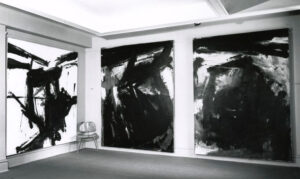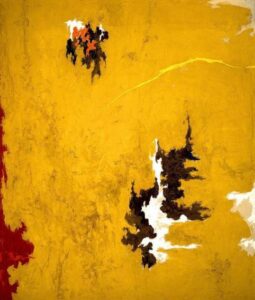Topic: Painting with big brushes
All the artists we looked at are American. They all worked in New York and became famous after the Second World War, because their work was so big, new and surprising: Mark Rothko, born in Russia 1903; Franz Kline, born in USA 1910; Ad Reinhardt , 1913, Clyfford Still, 1904.
We heard that in the USA after the war there was lots of building. Everything became BIGGER! Long, straight highways through the country, longer, faster cars and trains, tall buildings, huge bridges over the river, powerful machines, bigger planes, and more people moved into the cities. So there was more traffic, more noise. And the artists wanted to show this by making really big paintings, using big brushes with large brushstrokes to give the idea of how things looked different.
Mark Rothko said “I’m interested in showing emotions, or feelings, such as fear and sadness”. Franz Kline’s paintings remind you of buildings or bridges. They were often taller than he was; sometimes he put them flat on the floor and painted from above. Ad Reinhardt’s colours were dark, mysterious blues and Still’s looked like big advertisements with peeling paper, ripped edges and changes of colour. They were different because they didn’t show people, places or things, just big areas of colour and shape.
Rothko: “I’m interested in expressing basic human emotions: tragedy, joy, fear, sadness…if people only notice the colours in my work they are missing the point”.
Franz Kline: used broad brushstrokes of black, on white. He was influenced by the coal pits around him when he was growing up. These were enormous dark, noisy, powerful structures.
Ad Reinhardt: His earlier works were compositions of geometric shapes (squares, blocks, grids) Then later he made paintings in different shades of the same colour, all blue, all white, all red…
Clyfford Still: He was inspired by music and tried to express “the vastness and the depth” of a piece of music in his paintings. Also, he wished to give the feeling of the mystery of human existence.




